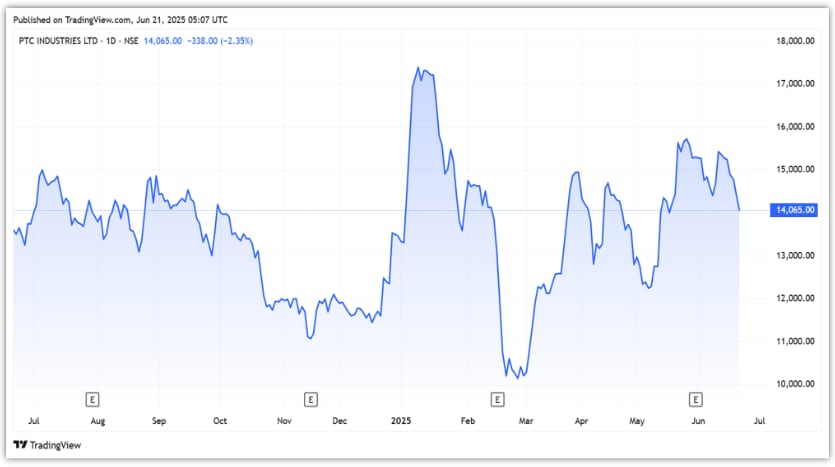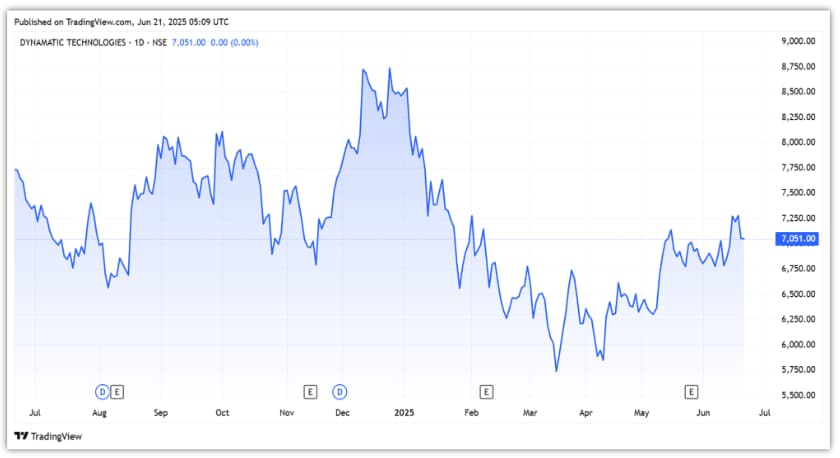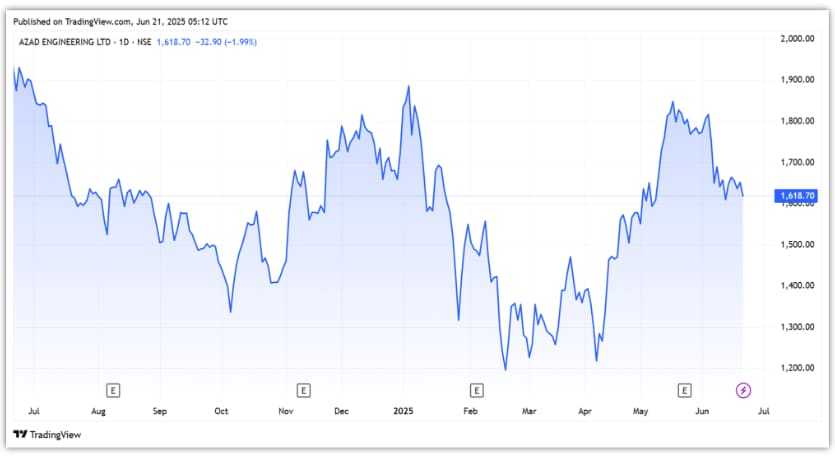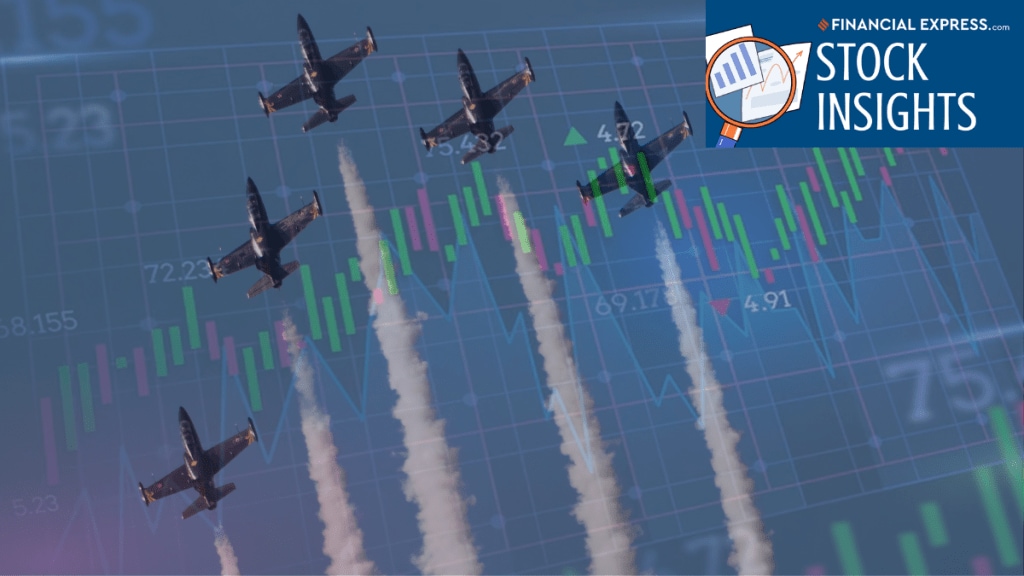Europe is rearming, and India is doubling down on its defence commitments. In response to rising geopolitical tensions, Europe recently unveiled the ReArm Europe Plan—its most ambitious push to strengthen its military capabilities.
At the same time, India continues to scale up its defence budget, with a growing focus on indigenisation and export potential. According to ICICI Securities, this twin push—one global, the other domestic—could support a more sustained order flow for Indian defence manufacturers. For investors, this raises the question: which listed companies stand to benefit from this changing landscape?
In their report, ICICI Securities highlighted three stocks. Let’s dig into these stocks that could be worth tracking as global and domestic defence capital expenditure gain traction.
#1 PTC Industries
PTC Industries is one of the leading manufacturers in the engineering sector, serving the aerospace, defence, oil & gas, paper, power and marine industries. Within defence, it caters to air, land, naval, and space, as well as aero engines and civil aviation.
The company has a diversified product profile, including special castings, machined components, and fabricated parts made from metals such as Stainless Steel, Duplex Stainless Steel, Super Duplex Stainless Steel, and other high alloys.
PTC has a reputed client base including Rolls-Royce, Dassault Aviation, Hindustan Aeronautics (HAL), the Ministry of Defence (MoD), and Israel Aerospace Industries. This has led to repeat business over the years, supporting its revenue growth.
PTC has established a strong presence in the export markets, which generate more than 80% of its overall revenue. Within the export business, its revenue is diversified across countries, including Finland, Norway, the US, China, and the Netherlands.
Financials stable, margins expanding.
In FY25, total income rose 27% to ₹3.4 billion, while net profit increased by 44.5% to ₹0.61 billion. Operating margin remained stable at 32%, compared to 31.8% in the previous year. However, its return on equity (RoE) declined to 4.4% from 8.6% in FY23 due to front-loaded equity infusion.
RoE is expected to recover as new capacities become operational.
Acquisitions and aerospace orders boost growth potential.
Looking ahead, the company is expanding its aerospace casting facility in the UP Defence Industrial Corridor. This will help it diversify its product portfolio and strengthen its presence in the defence sector.
The company also recently acquired Trac Precision, a UK-based precision engineering firm. Trac designs and manufactures precision components for the aviation, defence and power sectors. This acquisition will give PTC planning and machining capabilities it previously lacked, thereby further integrating and strengthening its operations.
In other developments, its subsidiary, Aerolloy Technologies (ATL), has successfully produced aerospace-grade titanium alloy ingots in trials. ATL supplies components used in CFM’s LEAP-1A/1B engines, which are relatively efficient & environmentally friendly.
CFM International is a 50-50 joint venture between GE Aerospace (US) and Safran Aircraft Engines (France) that manufactures jet engines. Over 370 LEAP-powered aircraft are operational in India, with more than 2,000 engines on order. This offers a huge opportunity to tap into.
To this end, it has recently secured an order from SAE for seven cast aeroengine components. This strengthens ATL’s ties with a global manufacturer and supports India’s growing role in the global aerospace supply chain.
The company’s revenues are expected to grow meaningfully, driven by scale from its Trac acquisition and the ongoing facility expansion. The stock trades at a price-to-earnings (P/E) multiple of 341, significantly above its 10-year median of 52.

#2 Dynamatic Technologies
Dynamatic Technologies manufactures highly engineered and critical products for the aerospace and defence, metallurgy and hydraulic sectors. It is one of the world’s largest producers of hydraulic gear pumps, holding a 70% market share in India’s tractor sector.
It is also a leader in high-precision airframe structures and aerospace components. The company supplies these to global aerospace companies, including Airbus, Boeing, Bell Helicopters, Dassault Aviation, Deutsche Aircraft and HAL.
Additionally, it manufactures complex, high-precision metallurgical iron castings for use in performance-critical components such as turbochargers and exhaust manifolds. Metallurgical clients include Audi, BMW, Volkswagen, and Daimler.
Its diversified manufacturing facilities in India, the UK and Germany benefited it as customers sought local suppliers after the pandemic. Revenue is also well diversified. 43% of revenue comes from aerospace, 33% from hydraulics and 24% from metallurgy.
Aerospace drives growth as metallurgy drags
From a financial perspective, revenue declined 1.8% over the previous year to ₹14 billion in FY25. The decline was primarily driven by a 29% fall in the metallurgical segment, due to subdued industrial demand. In contrast, the aerospace and hydraulics segments grew 19% and 2.2%, respectively.
Net profit (excluding exceptional items) rose 26% to ₹0.43 billion, supported by lower input costs. Segment-wise, aerospace leads on profitability with a 26% margin, followed by hydraulics at 5.3%, and metallurgy at 3%.
Growing defence vertical
Looking ahead, the company is positioned to benefit from new orders and government support for domestic defence manufacturing. Its European manufacturing base and partnerships with global companies further enhance its positioning.
In line with this, the company has inaugurated a Rear Fuselage Assembly Line for the D328eco turboprop aircraft in Bengaluru, in partnership with Deutsche Aircraft. This places Dynamatic to tap into India’s growing regional aviation sector.
It has also partnered with Airbus to manufacture all types of doors for the A220 regional jet at its Indian facilities. First-article inspections are expected to begin this September.
In the hydraulics segment, the company expects a revival driven by increased construction and agricultural activity, supported by a favourable monsoon. It is focusing on increasing aftermarket share, improving operational efficiency, and value engineering to boost margins.
Within the metallurgy segment, the company is working on cost reduction, rationalising low-margin products, and developing aerospace-grade castings and forgings, which is expected to support growth in the coming quarters.
The company trades at a P/E of 111, double its 10-year median of 50.

#3 Azad Engineering
Azad Engineering is engaged in manufacturing precision-forged and machined components for the clean energy, aerospace, defence, and oil and gas sectors. The company manufactures all types of blades for both radial and axial flow applications.
The business can be broadly divided into three key areas: energy, aerospace, and oil and gas. It has long-term contracts with reputed customers in the domestic and export markets. Clients in the energy segment include General Electric, Mitsubishi, BHEL, Siemens, and Toshiba.
In aerospace, its customers include Honeywell, GE Aviation, Rafael, and HAL, among others. Export sales are well-diversified across the US, UK, Europe, Japan, and the Middle East.
Defence and aerospace drive growth
From a financial standpoint, revenue grew 33% to ₹4.5 billion in FY25. Revenue growth was driven by aerospace & defence, which grew 84%, followed by energy (26%). Oil & gas contributed 79% of overall revenue, aerospace & defence 18%, and other segments the remaining 3%.
The company now earns 92% of its revenue from exports, with only 8% coming from the domestic market. Net profit surged 51% to ₹0.9 billion, with margins expanding 180 basis points to 36.3%.
Looking ahead, Azad has an order book exceeding ₹60 billion, providing revenue visibility for over a decade. These orders are scheduled for execution over 3–6 years, and the company is targeting over 30% revenue growth in FY26.
Azad expects the aerospace and oil & gas segments to grow faster than the company average. Over the medium term, it estimates that energy will contribute 55–60% of revenue, with the rest from aerospace, defence, and oil & gas.
Capacity expansion underway
The company is building a mega manufacturing facility, with Phase I currently under development. Phase II will commence afterwards. Once commercialised, full ramp-up is expected to take 12–18 months. The company expects an incremental asset turnover of 2x over time, from new facilities.
The company trades at a P/E of 118. It has a limited trading history, which makes it challenging to assess its valuation.

Conclusion
India’s defence manufacturers are well-positioned to benefit from rising global and domestic military spending. While PTC Industries, Dynamatic Industries, and Azad Engineering offer intense exposure to aerospace and defence opportunities, their valuations already reflect high growth expectations.
Disclaimer:
Note: Throughout this article, we have relied on data from http://www.Screener.in and the company’s investor presentation. Only in cases where the data was not available have we used an alternative, but widely accepted, source of information.
The purpose of this article is only to share interesting charts, data points, and thought-provoking opinions. It is NOT a recommendation. If you wish to consider an investment, you are strongly advised to consult your advisor. This article is strictly for educational purposes only.
About the Author: Madhvendra has been deeply immersed in the equity markets for over seven years, combining his passion for investing with his expertise in financial writing. With a knack for simplifying complex concepts, he enjoys sharing his honest perspectives on startups, listed Indian companies, and macroeconomic trends.
A dedicated reader and storyteller, Madhvendra thrives on uncovering insights that inspire his audience to deepen their understanding of the financial world.
Disclosure: The writer and his dependents do not hold the stocks discussed in this article.
The website managers, its employee(s), and contributors/writers/authors of articles have or may have an outstanding buy or sell position or holding in the securities, options on securities or other related investments of issuers and/or companies discussed therein. The articles’ content and data interpretation are solely the personal views of the contributors/ writers/authors. Investors must make their own investment decisions based on their specific objectives, resources, and only after consulting such independent advisors as may be necessary.


